Books
Books
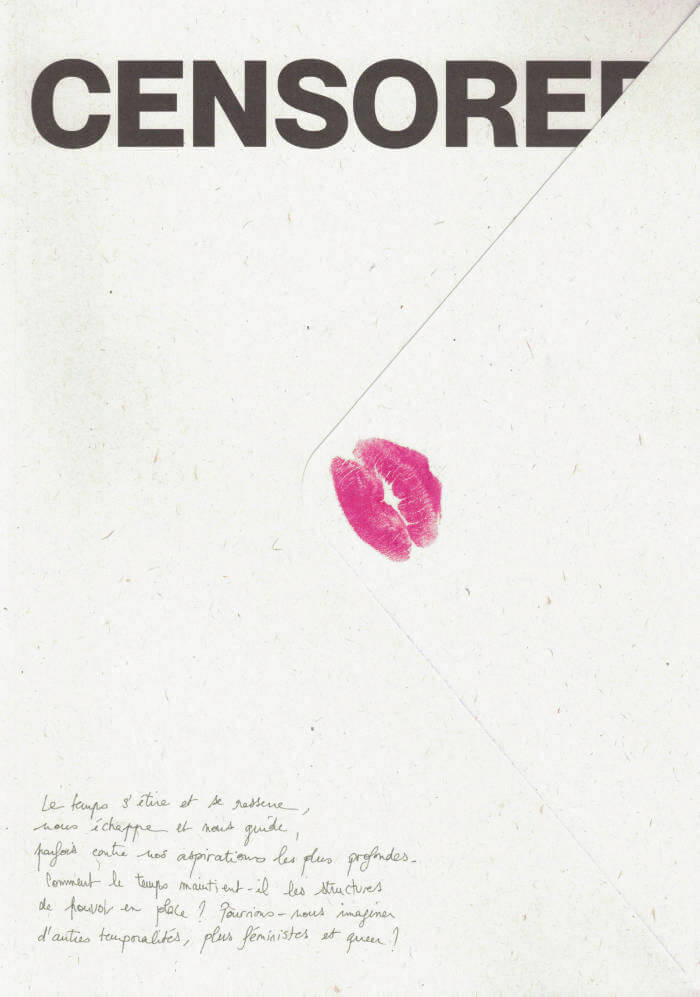
CENSORED 09 - It's About Time!
"Vous rappelez-vous de la dernière fois où vous vous êtes ennuyé·e ? Comment le temps maintient-il les structures du pouvoir en place ? Pourquoi la génération “working girl” ne fait-elle plus rêver ? Pourrions-nous imaginer d’autres temporalités, plus féministes et queer ? Dans son numéro “IT’S ABOUT TIME!” sous forme d’enveloppe géante, la revue Censored examine le concept du temps d’un point de vue féministe. Elle explore la manière dont le rythme de la vie est régi par des exigences sociales normées en abordant notre relation au travail, à la maternité, à la lutte et à la notion de liberté."
À travers des dialogues entre différentes époques, il explore des thèmes tels que la performance, les amitiés créatives et le repos et le divertissement. L’édition inclut des archives, dont un entretien entre Angela Davis et Toni Morrison, des lettres de plusieurs auteurices et poét-esses contemporain·es, des analyses, séries de photos ainsi que cinq cartes blanches à des artistes.

Les Éditions des mondes à faire
« Du fric ou on vous tue ! »
« Du fric ou on vous tue ! : j’ignore qui avait pu écrire ça sur un mur, au début des années 1980, à Marseille, mais j’avais bien aimé cette menace de braqueur qui résonnait là comme une injonction plus générale à ceux qui tiennent les cordons de la Bourse. »
Une association de hors-la-loi révolutionnaires, ainsi pourrait-on qualifier le groupe Os Cangaceiros, qui prit ce nom en hommage aux bandits du Nordeste brésilien. Ce livre raconte l’histoire de cette bande de jeunes qui, refusant d’aller travailler, s’était organisée pour arnaquer les banques et prêter main-forte aux luttes qui secouaient alors les prisons, les usines et les banlieues.
Ce récit de première main peut être lu comme une contre-histoire de la décennie 1980, durant laquelle se mit en place le régime de gouvernance que nous subissons depuis.
Alèssi Dell’Umbria est l’auteur de : Histoire universelle de Marseille. De l’an mil à l’an deux mille (Agone, 2006) ; C’est de la racaille ? Eh bien, j’en suis ! À propos de la révolte de l’automne 2005 (L’Échappée, 2006) (réédité et augmenté sous le titre La Rage et la Révolte en 2010 par Agone) ; Échos du Mexique indien et rebelle(Rue des cascades, 2010) ; R.I.P. Jacques Mesrine (Pepitas de calabaza, 2011) ;Tarantella ! Possession et dépossession dans l’ex-royaume de Naples (L’œil d’or, 2016) ; Istmeño, le vent de la révolte. Chronique d’une lutte indigène contre l’industrie éolienne, Livre-DVD (Collectif des métiers de l’édition / Les éditions du bout de la ville, 2018) ; Antimatrix (La Tempête, 2021).

Guerre Sonore
Le sonore excède nos capacités de pensée, il traverse toutes les échelles de la réalité et de la vie sociale, et nous permet d’expérimenter par avance les menaces du futur proche : ce sont les hypothèses que déploie dans sa Guerre sonore le DJ, producteur de bass music et théoricien Steve Goodman, mieux connu sous le pseudo Kode9, et formé au sein de l’Unité de Recherché sur la Cyberculture (CCRU) aux côtés de Kodwo Eshun et Mark Fisher. Guidé par les leçons des sound-systems et des raves, défiant le partage entre philosophie et science-fiction, il compose avec ce livre une vaste fresque fractale, qui analyse les limites de l’audible et les puissances sensorielles et spéculatives de la vibration. Guerre sonore décrit comment la maîtrise des infrabasses et l’occupation de l’espace sensoriel sont devenus l’enjeu d’une bataille secrète mais généralisée où les gouvernements, les spécialistes du marketing, les designers et les technoscientifiques s’affrontent au matérialisme des basses fréquences des artistes et des populations.
Steve Goodman (alias Kode9) est un musicien, écrivain et artiste. Il est l’auteur du livre Guerre Sonore et il codirigé les ouvrages Unsound : Undead (Urbanomic Press, 2019) et Ø (Flatlines Press, 2021). Il a fondé les labels Hyperdub et Flatlines, produit 5 albums, dont deux avec le regretté Spaceape (Memories of the Future, 2006 et Black Sun, 2012) et 3 en solo (Nothing, 2015, Escapology, 2022, Astro-Darien, 2022), de nombreuses compilations de mix DJ ; il a co-compilé et remixé Diggin in the Carts (2018), une collection de musiques rares de jeux vidéo japonais. Il a aussi, entre autres choses, conçu des installations sonores pour la Hyundai Commission à la Tate Modern en 2018 et pour l’exposition sur l’intelligence artificielle More than Human en 2019, au Barbican de Londres.

Rage Assassine: Mettre Fin au Racisme
Avant que Black Lives Matter et #MeToo ne viennent secouer l’Amérique et le monde occidental, bell hooks montrait, dans cet essai incisif, que l’abolition du racisme et l’éradication du sexisme vont de pair. Sans le féminisme, la lutte antiraciste reste une affaire d’hommes. Sans l’antiracisme, le féminisme s’expose à servir de courroie aux logiques de domination raciale. L'autrice insiste sur le bien-fondé de la rage qui anime les masses populaires et la jeunesse noire et sur la nécessité d’en faire un moteur de changement social radical. Elle propose une théorie et une pratique révolutionnaires, dont la fin est une communauté solidaire fondée sur l’égalité réelle et la volonté de tou.te.s de travailler au changement.
Traduit de l'anglais par Ségolène Guinard.
GLORIA JEAN WATKINS, connue sous son nom de plume BELL HOOKS, née en 1952, est une intellectuelle, féministe, et militante étasunienne. Elle a publié plus de trente livres et de nombreux articles, et est apparue dans plusieurs films documentaires. Traduits dans de nombreuses langues, ses ouvrages sont considérés parmi les plus importants sur la question aux Etats-Unis et suscitent un réel engouement en France depuis quelques années. Les éditions divergences ont déjà traduit et publié trois de ses ouvrages dont La volonté de changer et A propos d'amour.

Masturbatory Reader (2nd edition)
This Masturbatory Reader asks three main questions.
1. What power and pleasure can we access through attending to the erotics of knowledge production?
2. How are the sites, systems and tools of knowledge-making designed to reiterate violent norms (and in turn, erase deviant practices)?
3. What could the making (and unmaking) of these systems allow us to imagine?
To unpack these questions the edition gathers 16 contributors across 136 pages, conjuring the thinking (wondering, studying, lusting, sweating, ranting) of an expanding chorus of references that sit distances apart, folded here between facing pages. A chorus calling to action, calling to theory, calling to bed.
Featuring D Mortimer, Wes Knowler, Biogal, Tallulah Griffith, Brooke Palmieri, Carl Gent, Sophie Mak-Schram, Alice Butler, Jessa Mockridge, Nat Pyper, Alton Melvar M Dapanas, Sammy Paloma, Donna Marcus Duke, and Ryan Boultbee, with a forward by Emily Pope.
“In this anthology, reading is cruising, and cruising is reading.” – Sam Moore, ‘The (Bad) Taste Test: Radical Acts of Queer (Self) Pleasure in The Masturbatory Reader’, Polyester Zine

Chesil Cliff House and other failures
Orbiting around the saddest house in the history of Grand Designs, Sam Moore’s Chesil Cliff House and other failures takes us to North Devon where, standing at the cliff’s edge, we meet Edward Short: a man with a Fred Perry shirt and a dream. Amongst a chorus of characters including Kevin Mcloud as Father Time, Moore by means of Short leads us into a study of creative failure, gender, and, ultimately, the desire to keep writing.
"I struggle to see anyone living here. It feels like a distorted wonder of the world, a cautionary tale. Something that could never have been lived in, but that had to be made."
About the author:
Sam is a writer, artist, and editor. They are the author of All my teachers died of AIDS (Pilot Press), Long live the new flesh (Polari Press), and Search history (Queer Street Press). They are one of the co-curators of TISSUE, a trans reading and publishing initiative based in London.
About A Series of Attempts:
This new series published by Sticky Fingers Publishing explores the essay form through the etymological root of essay: to try, trial or attempt. In 1508, French theorist Michel de Montaigne published a collection of 107 texts called Essais, described by his contemporaries as ‘self-indulgent and embarrassingly confessional.’ It is through these roots we find the attitude and intentions at the heart of this series; that through thinking together, through trying to figure it out on the page, we can reach new and increasingly nuanced ways to understand each other and the worlds we inhabit.

I love you forever is murder
Here, in a work of trans pessimism, amy etherington asks what love and grief mean in a world that wants you dead. Speaking to a structural, architectural violence, I love you forever is murder imagines transness as an exit, which then implies a reentry. Understanding love and grief as inextricably entangled, etherington examines how trans people are often met with grief by those who claim they love them.
Part break-up text, part grief-oriented trans theory, part whispering, pricking, ghostly presence-from-beyond-the-grave, etherington calls upon Lacan through Edelman, Freud, Derrida, and the voices of friends, writing with an aching warmth and confessional intimacy that seeks to live, write, go on, after your own passing.
About the Author
amy etherington is an educator–researcher–writer, exploring grief, death and transness and how they sit by the edges of things. Her writing feels through/with a pessimism that there might only be no place for transexuals in this World, itself an imagining wrought from our violent unmaking. Her teaching work seeks ways to resist the institution a little longer from within its grounds, through collaborative investigation of care and caring practices with students. @amy.ether
About a Series of Attempts:
This new series published by Sticky Fingers Publishing explores the essay form through the etymological root of essay: to try, trial or attempt. In 1508, French theorist Michel de Montaigne published a collection of 107 texts called Essais, described by his contemporaries as ‘self-indulgent and embarrassingly confessional.’ It is through these roots we find the attitude and intentions at the heart of this series; that through thinking together, through trying to figure it out on the page, we can reach new and increasingly nuanced ways to understand each other and the worlds we inhabit.
Sticky Fingers Publishing is an intra-dependant press based in London. We are a feminist, queer, disabled-led publisher producing work at the intersection of design, academia, art, visual culture and performance.
.jpg)


FDBNHLLLTTFMOURNING
Tenth and final FDBN...* publication.
Featuring zack mennell, Biogal, James Sunderland, Fiona Glen, Jessie McLaughlin, Dan Schapiro, A Lyons, Stephanie Lones, Julian Konuk and Ioulitta Triantafyllou.
Guest edited by amy etherington.
Risograph and Thermography cover with flourecent green sticker black and white inners throughout.
*Fragile-Disorienting-Breakable-Naive-Hesitant-Loving-Lusting-Leaking-Trembling-Terrifying-Fucking-Mourning
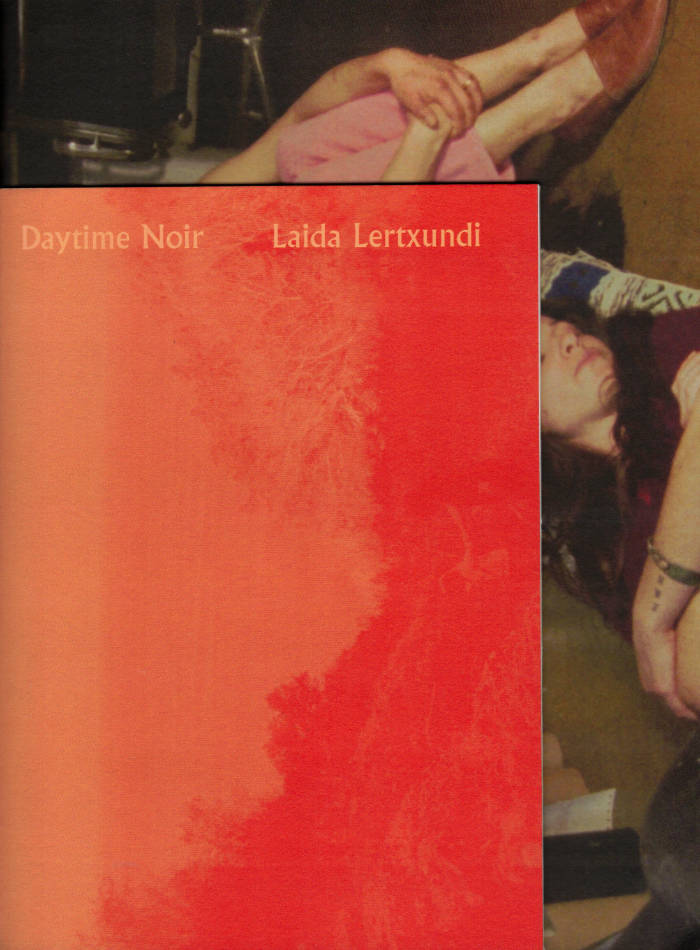
Daytime Noir
Daytime Noir is a limited edition artists book by Laida Lertxundi, designed by Gabrielle Pulgar and released by Artspace Aotearoa on the occasion of Scores for Transformation, the third in the cycle of exhibitions that orbit the question “where does my body belong?” The book includes new writing by Laida Lertxundi, Ren Ebel, and Luna Miguel.
Drawing on two recent 35mm films Autoficción (2020) and Inner Outer Space (2021) as well as recent works on paper, the pubilcation explores the parameters of what it takes to run an artistic practice navigating the many facets of a full life: parenting, teaching, exhibiting, working. The full colour, hand stitched book presents us with ‘film stills’ that come alive when we, as readers, engage with its physical form.
The pubilcation is an edition of 100.

Telling the Truth as It Comes Up: Selected Talks & Essays 1991-2018
An Expert Array of Talks & Essays by One of Our Greatest Living Poets.
One of our greatest living poets, Alice Notley, the author of more than 40 books of poetry, has delivered an expert array of talks and essays over the last three decades.
The publication offers a significant contribution to literature, reimagining the possibilities of writing in our time and the complicated business of how and why writers devote their lives to their craft. Whether she is writing about other poets—Ed Dorn, Allen Ginsberg, Homer, bpNichol, Douglas Oliver, or William Carlos Williams—noir fiction, the First Gulf War, dreams and what they're for, or giving us insight into her own work, Notley's observations are original, sobering, and always memorable. This collection often eschews the typical style of essay or lecture, resisting any categorization, and is consciously disobedient to academic structures in form. The results are thrilling new modes of thinking that may change the ways we read and write.
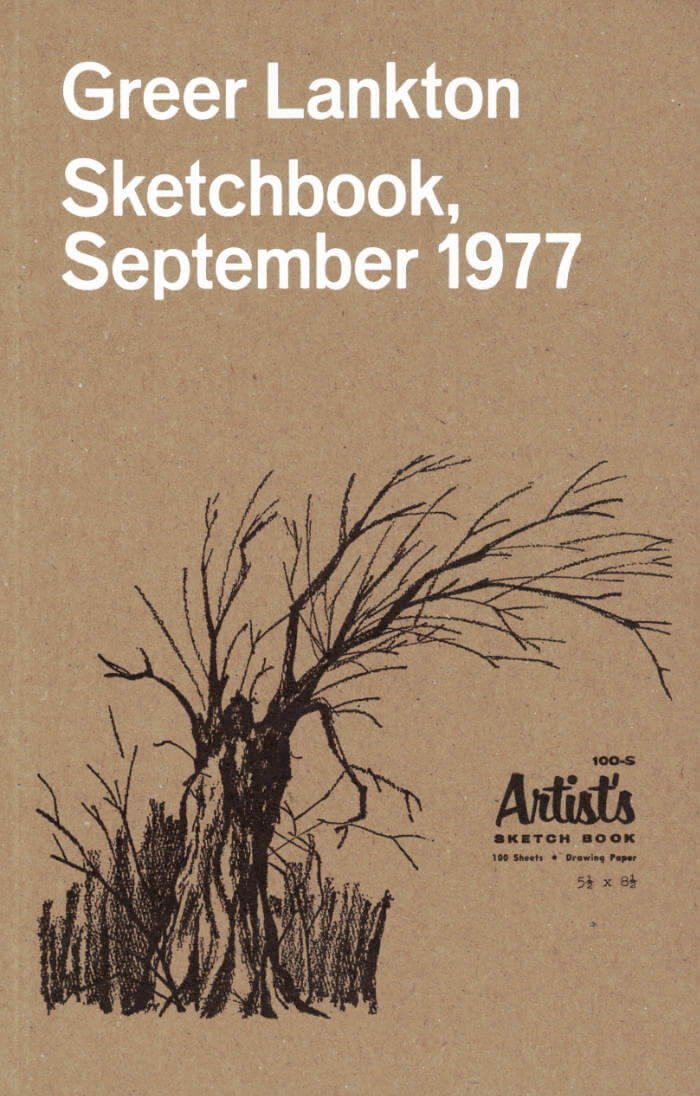
Greer Lankton: Sketchbook, September 1977
A fascinating account of Lankton's inquisitive, sociological and emotional ruminations in advance of her gender-affirming surgery.
This is one of the earliest of Greer Lankton's (1958-96) journals, sketchbooks and daybooks to appear in the artist's archives, and the first to be published in facsimile form. Written during her time as an art student at the School of the Art Institute of Chicago, the journal offers key insights into Lankton's mind at work before her career-defining move to New York in 1978, where she would become an important figure of the East Village art scene in the 1980s and early '90s with her lifelike dolls and theatrical sets.
Containing drawings, behavioral diagrams and aspirational, occasionally confessional writing, the journal is a record of imagining the body and mind reconciled through transformation. In these pages, the 19-year-old turns an inquisitive, sociological eye toward the emotional landscape and somatic effects of the days recorded here; days leading up to her decision to undergo hormone treatment and gender-affirming surgery in 1979. Lankton reflects with raw vulnerability and keen self-awareness on critical questions of self-image, social perception, gender normativity and human behavior.

Fia Backström: COOP: A-Script
COOP documents Swedish artist Fia Backström's (born 1970) performances of two recent scripts, continuing her exploration of language, marketing, disorders and performance. The first script operates according to two distinct logics: a four-part linear base structure and text material that was chosen and read during the performance through chance movement of the performer's body across a grid.
This publication was especially designed to reflect this type of unpredictable and spontaneous movement. Mathematical symbols have been embedded into the text and these symbols link to ones on the upper corner of pages with nonlinear material. These indicate where the text could be inserted during a performance, thus incorporating the form of performance into the book. The second script serves as an epilogue to the first and was performed by four voices, reading from beginning to end without assigned lines, sometimes simultaneously.
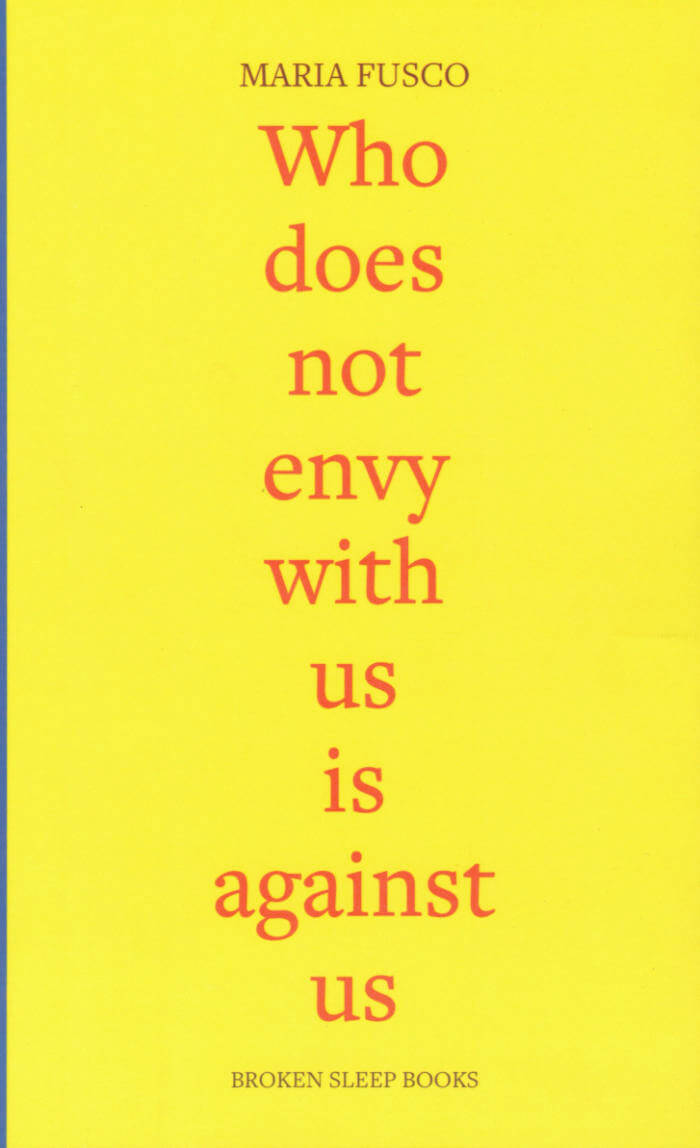
Who does not envy with us is against us: three essays on being working-class
Who does not envy with us is against us is a collection of essays on working-classness that demonstrates Maria Fusco's exceptional talent for weaving together the analytical and the poetic to create an affecting and profound work.
With expressive prose, Fusco deftly captures the experiences of the global working class, illuminating emotions that unite them across borders and lines. This is a tribute to the resilience and tenacity of working-class communities, and an invitation to readers to join in a deeper understanding of their struggles and triumphs. Through her masterful storytelling, Fusco utilises the power of language to elevate the voices of those who have long been silenced, creating a symphony of words that will echo long after the final page.
"I love this book with my entire life and beyond. Fact that I grew up a thousand miles south of Belfast, but, days after reading, feel like I'm - or should be - from there is testament to Fusco's analytic and lyric genius, and her ability to move and affect. Fusco mobilises a previously unnamed mood shared by the international, intergalactic working classes, I've never seen anything like it. Read this book." - Isabel Waidner, Corey Fah Does Social Mobility
.jpg)
Les déserteuses
The first novel by Swiss artist and writer Johana Blanc: haunted by woman figures having voluntarily ended their artistic career in the early 70', and fascinated by their radicality, a young artist asks herself how to carry on with her artistic practice without betraying her idols. Over the course of one evening, during which she attends a series of openings, the story follows her attempt to find her position among a fantasized art world, caught between a paradoxical reality and thwarted ambitions.
Johana Blanc (born 1990 in Paris), a graduate of the Head in Geneva, directs several micro-publishing projects such as the magazine Escalier and Éditions Cacahuète. Her artistic practices include installation and performance art. She also writes and has published several texts, whether collaboratively or not (Wages For Wages Against, Woman Cave).

Togetherward
A volume assembling new and existing documents that revisit, mix and remix moments in the work of artist Christian Nyampeta.
The volume is composed of affections, alliances, appearances, material, and memories that exceed singular authorship, in the form of dedications, documents, elegies, film stills, footnotes, photographs, poetry, presences, and translations. Together they draw a biography of research: the journeys of engaging with art learning and making in, with, and against the worlds of today.
This stream of existing documents is sequenced alongside new contributions by Omar Berrada, Binna Choi, Belinda Kazeem-Kaminski, Natacha Nsabimana, and Isaïe Nzeyimana.
The publication emerges from a close collaboration with GfZK (Galerie für Zeitgenössische Kunst, Leipzig) over the last three years. During this time, two projects were held at GfZK: A Flower Garden of All Kinds of Loveliness without Sorrow, 2018–2019, and Lovers in a Dangerous Spacetime, 2021.
Literature, history, theology and philosophy, as well as insights from experiences and encounters in practice between contemporary art and design percolated into the two exhibitions; public programs; and an ongoing scriptorium, in which the artistic works staged gatherings of artists, theorists and mythologists from Rwanda and further afield who would otherwise never meet.
Titled Togetherward, a word invented by philosopher and artist Denise Ferreira da Silva to describe the rhythm of Nyampeta's method, the volume preludes a series of publications in images, writing, sound, film, and musical recordings that revisit the layers and sediments of the global events of the previous decade—all driven by the burning question of how to live together.
Edited by Vera Lauf and Christian Nyampeta.

About Ed
A moving story about love, AIDS, grief, and memory by one of the most adventurous writers to come out of San Francisco's LGBTQ+ scene.
Bob Glück met Ed Aulerich-Sugai in 1970. Ed was an aspiring artist; Bob wanted to write. They were young men in San Francisco at the high tide of sexual liberation and soon, and for eight years, they were lovers, after which they were friends. Ed was an explorer in the realms of sex. He was beautiful, fragile, exasperating, serious, unassuaged. In 1994 he died of HIV. His dream notebooks became a touchstone for this book, which Glück has been working on for some two decades, while also making his name as a proponent of New Narrative writing and as one of America's most unusual, venturesome, and lyrical authors. About Ed is about Ed, who remains, as our dead do, both familiar and unknowable, faraway and close. It is about Bob too.
The book is a hybrid, at once fiction and fact, like memory, and it takes in many things through tales of political activism and domestic comedy and fury to questions of art and love and experiences of longing and horror. The book also shifts in register, from the delicate to the analytic, to funny and explicit and heartbroken. It begins in the San Francisco of the early 1980s, when Ed and Bob have been broken up for a while. aIds is spreading, but Ed has yet to receive his diagnosis. It follows him backward through his life with Bob in the 1970s and forward through the harrowing particulars of death. It holds on to him and explores his art. It ends in his dreams.

The Apple in the Dark
"It's the best one," Clarice Lispector remarked on the occasion of the publication of The Apple in the Dark: "I can't define it, how it is, I can only say that it's much better constructed than the previous ones."
A book in three chapters, with three central characters, The Apple in the Dark is in fact highly sculpted, while being chiefly a metaphysical book, and in this stunning new translation, the novel's mysteries and allegories glow with a fresh scintillating light.
Martim, fleeing from a murder he believes he committed, plunges into the dark nocturnal jungle: stumbling along, in a state of both fear and wonder, eventually he comes to a remote, quiet ranch and finds work with the two women who own it. The women are tranquil enough before his arrival, but are affected by his radical mystery. Soaked through with Martim's inner night (his soul is in the darkness where everything is created), the novel vibrates with his perpetual searching state of vigil. Often he feels close to an epiphany: "for the first time he was present in the moment in which whatever is happening is happening." Yet such flashes flicker out, so he's ever on the watch for "life to take on the dimensions of a destiny."
In an interview, Lispector once said: "I am Martim." As she puts it in The Apple in the Dark: "All I've got is hunger. And that unstable way of grasping an apple in the dark-without letting it fall."

nY52 — sex negativity
Persis Bekkering, Marija Cetinic and 2 more
Geïnspireerd door recente ontwikkelingen in queer en trans theory, het academisch discours in de traditie van de psychoanalyticus Jacques Lacan, en black studies, presenteert en lanceert nY met dit nummer het begrip ‘seksnegativiteit’, dat wijst op het destabiliserend, desoriënterend potentieel van seksualiteit, zonder er een nieuwe, gedroomde status quo tegenover te stellen.

“1 2 3 2 1”
“1 2 3 2 1” is a 304-page photo novel by Yao Yuan, that juxtaposes images created during and after Nagakura Nami’s pregnancy and the birth of her child, across 2017-2019. In parallel with images of Yuan’s personal life and journeys between Japan and China, “1 2 3 2 1” contemplates ancient allegories and worldings within the contemporary condition through a queer intimate vision.
The book portrays multitudes of cinematic cityscapes and natural sceneries, vigorous colors and mundane daily moments, containing the coexistence of rough emotions and banal transience. It ponders on an array of subjects such as time, memories, gender, borders, identity, spirituality, nature, healing, care, reality and mystery.
Yao Yuan (1988, CN) is a non-binary artist born in Sichuan, China. With their camera they engage with bodies, spaces and rituals to reflect on the fabric of identity. Their photographic work expresses an intrinsic curiosity for intersectionality and spirituality. Their investigations explore the power of storytelling and dramaturgy, to rethink the binary framework of dominant norms, particularly those that relate to gender and sexuality. The focus of Yuan’s work touches upon topics of non-normative narratives surrounding motherhood, nature, queer intimacy and representation.
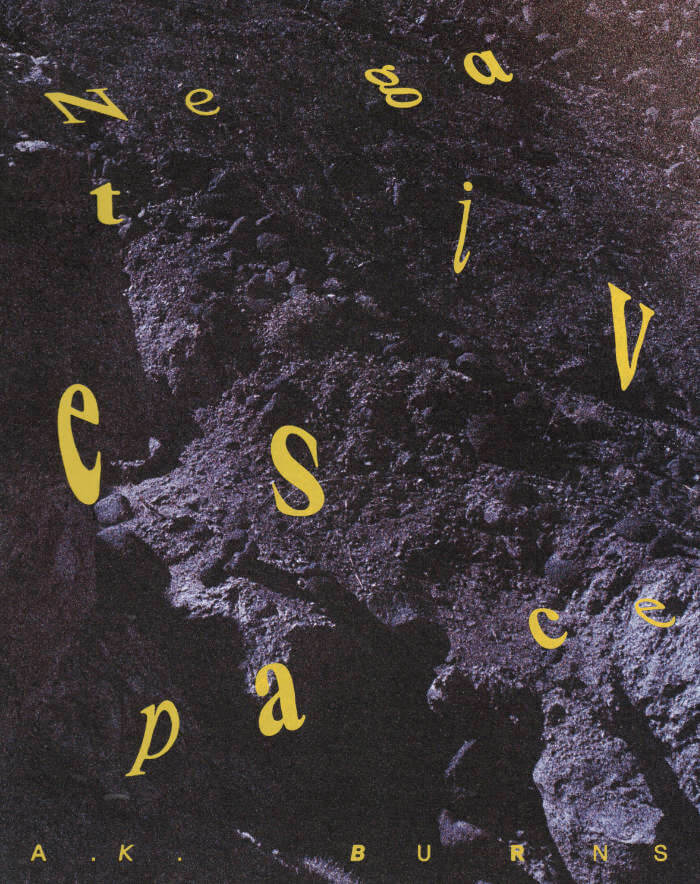
A.K. Burns: Negative Space
Chronicling an epic multimedia project 10 years in the making, A.K. Burns' first monograph grapples with climate change, community and sociopolitical agency
Deploying science fiction, material feminism, eco-anarchism, queer theory and technoscience, New York-based artist A.K. Burns (born 1975) explores the fraught relationships between humanity and nature in an epic multimedia work, Negative Space (2015-23). This nonlinear allegory provokes questions about marginalized bodies, environmental fragility and technology. Developed as a cycle of four video installations, Negative Space imagines new relationships to the spaces we occupy and the impact of our bodies in these spaces through imagery, research and critical and creative writings. Set in a speculative present, the tetralogy envisions a new materialist cosmology wherein hierarchical relations are transformed.
Edited by Karen Kelly and Barbara Schroeder
Text by CA Conrad, Mel Y. Chen, Aruna D’Souza, Megan Hicks, Simone White, and a conversation between the artist and Karen Archey
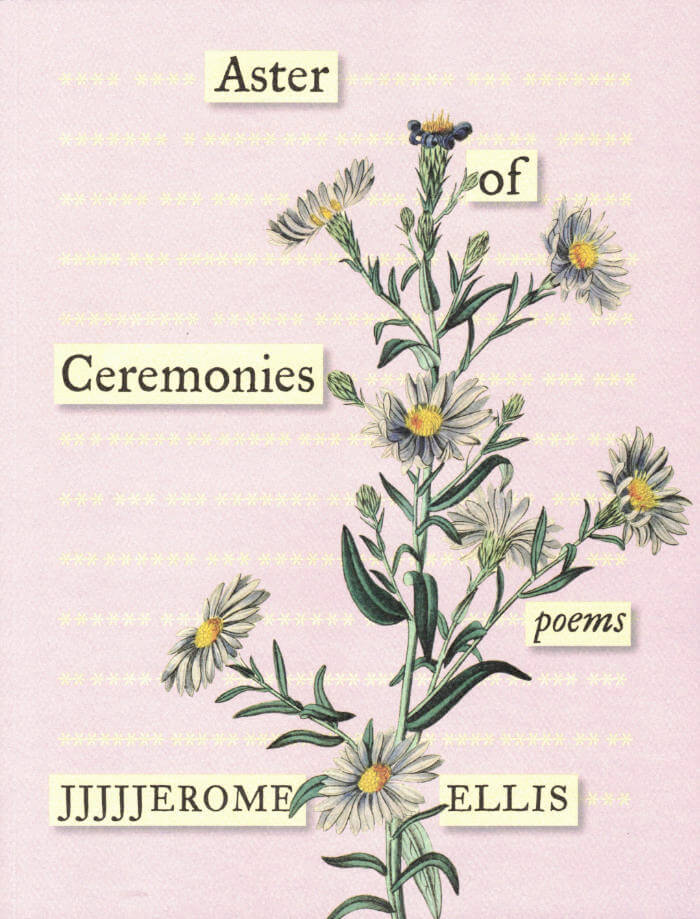
Aster of Ceremonies: Poems
Aster of Ceremonies asks what rites we need now and how poetry, astir in the asters, can help them along. What is the relationship between fleeing and feeling? How can the voices of those who came before—and the stutters that leaven those voices—carry into our present moment, mingling with our own? When Ellis writes, "Bring me the stolen will / Bring me the stolen well," his voice is a conduit, his "me" is many. Through the grateful invocations of ancestors, Hannah, Mariah, Kit, Jan, and others, and their songs, he rewrites history, creating a world that blooms backward, reimagining what it means for Black and disabled people to have taken, and to continue to take, their freedom.
A polyphonic new entry in Multiverse—a literary series written and curated by the neurodivergent—JJJJJerome Ellis's Aster of Ceremonies beautifully extends the vision of his debut book and album, The Clearing, a "lyrical celebration of and inquiry into the intersections of blackness, music, and disabled speech" (Claudia Rankine).
JJJJJerome Ellis is the author of Aster of Ceremonies. He is an animal, stutterer, and artist. He is also the author and composer of The Clearing, an audio-textual project that investigates how stuttering, blackness, and music can be practices of refusal against hegemonic governance of time, speech, and encounter. His work has been presented by the Lincoln Center, the Poetry Project, MASS MoCA, REDCAT, Arraymusic, and the Center for African American Poetry and Poetics, among others. He lives in Tidewater, Virginia, where he was raised by Jamaican and Grenadian immigrants.

In Part: Writings by Julie Ault
Spanning more than three decades, In Part brings together a full spectrum of the New York-based artist, writer and activist Julie Ault's (born 1957) published texts through carefully selected extracts in a single volume.
Reprinted in chronological sequence alongside a selection of full-length texts, this series of excerpts offers a timeline of Ault's continuous artistic growth, longstanding political concerns and dynamic interpersonal affinities.
Beginning in the 1980s with texts written with her collaborators in Group Material, In Part highlights Ault's shift from exhibition making in the mid-1990s to include publishing and writing. Ault's dialogic practice extends to the present day through her sustained engagements and relationships with such artists as Corita Kent, Felix Gonzalez-Torres, Nancy Spero, Martin Beck, David Wojnarowicz, Liberace and Martin Wong.
Lucy R. Lippard contributes an introduction.